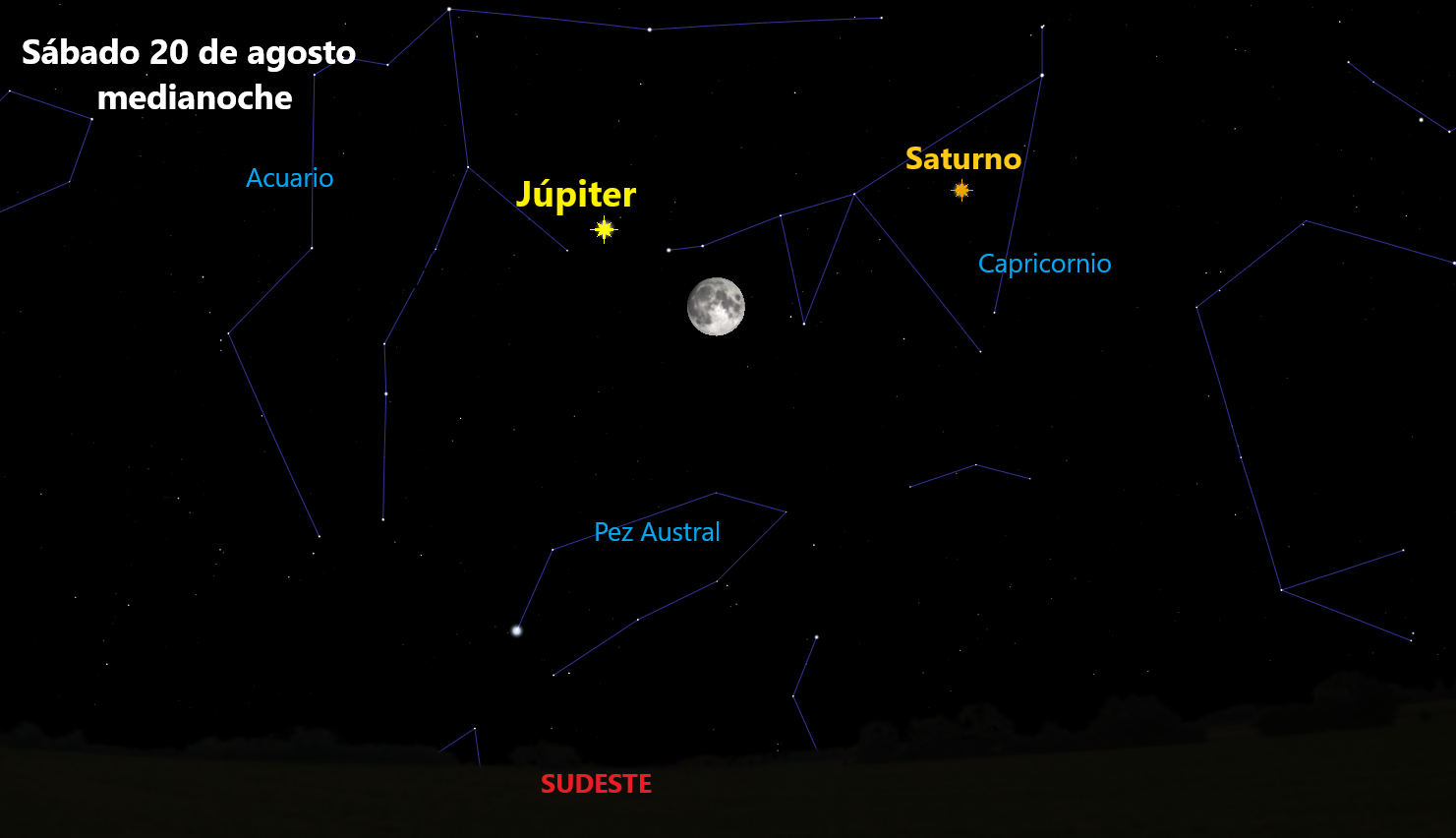Excellent year for the Perseids: a complete guide to its observation
Moon formation on a young exoplanet
This weekend we have Jupiter in opposition.
Illuminated frontally by the Sun and at its minimum distance from Earth, it is the time of year when it is brightest.
Opposition
Jupiter is very easily located on these summer nights.
It is located on the border between the constellations of Aquarius and Capricorn, and is now the brightest star in the sky after the Moon and Venus (which shines in the west after sunset).
The gas giant rises in the east shortly after sunset, gains height as the night progresses, and hides at dawn in the west.
Jupiter in opposition
This weekend, Jupiter is in opposition. This means that Jupiter, Earth, and the Sun will all be on the same straight line. The opposition took place exactly on Friday the 20th. In this configuration, Jupiter is as close as possible to our planet, but even so, its distance reaches 600 million kilometers. Earth and Jupiter can be seen as two corridors moving through their respective streets (the orbits). On the 20th, our planet, which was coming behind Jupiter, has reached its height and has overtaken it. It is a phenomenon that repeats itself every 13 months.
In this configuration, the giant planet rises as the Sun goes down and passes through the sky to lie down at dawn.
In the middle of the night it is at about 50 degrees elevation in unbeatable conditions for observation from Spain.
In astronomical terms: its magnitude is now -2.9 and its apparent diameter measures 49 arc seconds (about 40 times less than that of the full moon).
Conjunction of Jupiter and the Moon
On the night of Saturday 21 to Sunday 22, the full Moon will come to be very close to Jupiter to form a beautiful conjunction that will be visible even in the illuminated skies of the cities.
Huge storm
If you have good binoculars or a small telescope, it will be possible to observe the characteristic cloud bands of Jupiter, its four largest satellites - Io, Europa, Ganymede and Callisto - and, above all, its great red spot, a gigantic anticyclonic storm. which has lasted for more than three centuries.
At about 12,000 kilometers in size in the North-South direction (similar to the size of the Earth) and some 30,000 kilometers in an East-West direction, it is undoubtedly the largest storm in the solar system.
The gas rotates in the spot in the counterclockwise direction, generating violent jet streams to the south and north of the spot.
In the outer regions of the periphery of the spot, hydrodynamic instabilities create complex rippled structures.
The reddish color of the great spot is still a mystery.
Its cause must be found in the chemical composition of the gas, perhaps due to an overabundance of phosphorus or sulfur compounds, or perhaps organic compounds to be determined.
It is also unknown how long this huge storm will last.
Saturn, Venus and Mercury
Jupiter is still paired with Saturn. Let us remember that both giant planets staged a great conjunction last Christmas and, since then, they have been gradually separating in the sky. They are now about 15 degrees apart (that is, about 30 times the diameter of the full moon). As we look towards Jupiter, look for Saturn to the right and a little higher on the horizon. Despite passing through their opposition on August 2, the ring giant shines 20 times dimmer than Jupiter, with a discreet reddish color.
There are now two other planets that are visible to the naked eye.
Venus can be seen shining splendidly to the west at twilight.
These days it is about 180 million kilometers away.
This is 3.3 times closer than Jupiter, which makes it possible that, despite its much smaller size, Venus appears 2.5 times brighter than the giant planet.
The elusive Mercury begins to be seen from this weekend also in the sunsets, but, as usual, close to the Sun and very low above the horizon, which makes its observation require much more attention than that of Venus.
In case you are wondering about Mars, keep in mind that it is now in the direction of the Sun and is not observable.
As we approach autumn, the nights lengthen and begin earlier.
Once the last heat wave and haze are over, hopefully the weather will cool, but keep the sky clear of clouds to enjoy the great Jupiter in all its splendor.
________________________________________________________
Rafael Bachiller is director of the National Astronomical Observatory (National Geographic Institute) and academic of the Royal Academy of Doctors of Spain.
According to the criteria of The Trust Project
Know more
Science and Health
science
They find a "fearsome" flying dinosaur, "the closest thing in real life to a dragon"
AstronomyExcellent year for the Perseids: a complete guide to observing them
StoriesSpain, hot spot of climate change: 3.5 degrees more, fires and droughts
See links of interest
Last News
Work calendar
Home THE WORLD TODAY
Master Investigation Journalism
Direct afghanistan
Stage 7 of the Vuelta: Gandía - Balcón de Alicante
RB Leipzig - VfB Stuttgart
Real Betis - Cádiz
Brest - Paris Saint-Germain
Stage 8, live: Santa Pola - La Manga del Mar Menor

